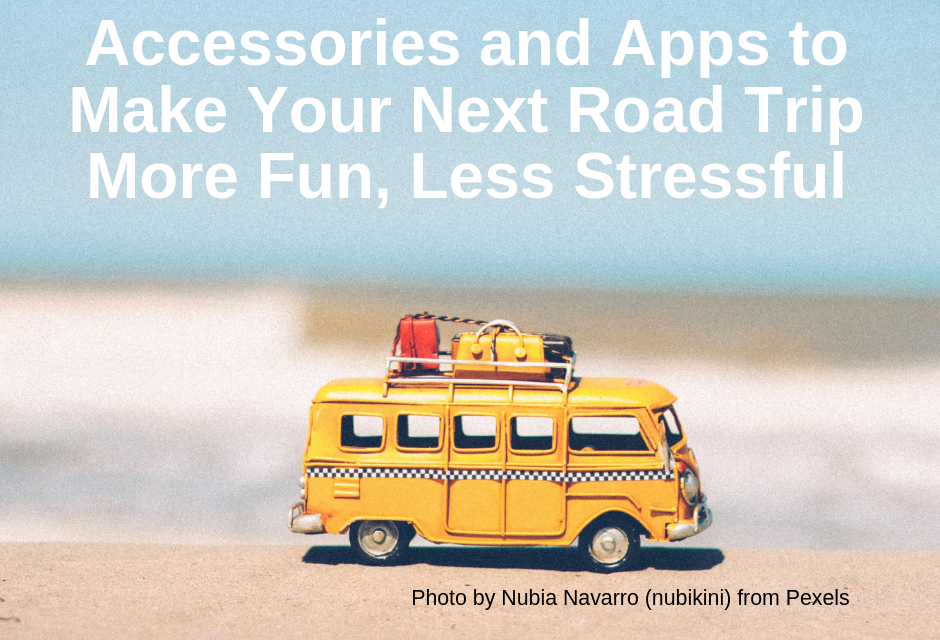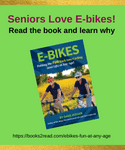Note to readers: Some of the links on thisretirementlife.com are affiliate links from which we receive a small commission from sales of certain items, at no extra cost to you. As an Amazon Associate and a participant in other affiliate marketing programs, we earn from qualifying purchases. These commissions help support this blog so we can continue providing timely and useful information about living life to the fullest during the retirement years. See the full disclosure statement here.
It’s time to get moving on your travel bucket list. The road ahead beckons.
One of the real joys of retirement is finally having the time to travel. If you are like us, much of that travel is by car, SUV, or minivan — or maybe an RV. New gadgets and technology are making road travel easier. Just look at the impact of GPS technology, for instance. No more arguing over torn road maps! Kathy and I jokingly say our marriage might not have survived these four decades if we still relied on maps while driving.
Before you pack for your next road trip, here are tips on the best gadgets, accessories and apps to make your travels more fun and less stressful.
Navigation apps and devices
These days, you simply must have GPS navigation assistance. Cities are larger and more complex. Road trips often take us down unfamiliar highways, far from home. Let’s be honest; even if we wanted to keep using maps, our vision isn’t what it used to be.
Assuming you own a modern smartphone (like an iPhone or its Android equivalents), all you may need to do is download your favorite GPS apps, including popular choices such as Apple Maps, Google Maps, Waze, Where To?, and MapQuest. Each has benefits, so which one you use will be a matter of personal choice. Waze is the most unique. It uses crowdsourcing, meaning its timely traffic data comes from other Waze users. It’s the best choice for spotting road hazards or police ahead. We prefer to have ready access when traveling to at least two GPS apps. If one app fails to load or isn’t giving us the information we need, we simply try another one.
If you drive a newer-model vehicle, it may have GPS built into the dash’s infotainment system, offering an alternative to using your phone. These built-in systems are improving, but cellphone map apps have advantages. Your cellphone gives you a broader choice of map services (see above), which are always up-to-date and improving. Plus, many of the cellphone apps will sync with your phone’s calendar and other data. Still, if you’re happy using the vehicle’s built-in GPS, that’s fine.
Standalone GPS devices such as those from Garmin, Tom Tom and Magellan are still worth your consideration. This is especially true if you own an older phone or one without a large data plan, or if you drive a vehicle without dashboard GPS. Even drivers with the latest smartphones may find it preferable to have a separate device for GPS, so phone calls or other distractions don’t disrupt from your navigation. Using phone map apps while driving can quickly drain your cellphone’s battery and use up data. Modern GPS devices are feature rich, interact with your cellphone, and have greatly improved screens. One popular model with good reviews and a larger-than-average screen is the Garmin DriveSmart 61 NA LMT-S.
Keep it Cool
Coolers have long been a road-trip staple, but today’s coolers are far better than the ones of old. Today’s mid-grade or higher-end coolers keep drinks and other contents colder for much longer, thanks to improved insulation and materials. If you haven’t upgraded your cooler in more than a decade, it’s probably time to replace it with a newer model.
One of our best discoveries for longer road trips is an electric, plug-in cooler for vehicles. It’s like having a refrigerator in your car. We took a month-long road trip last fall, and our new electric cooler kept our contents cold and performed like a champ. We love it. As a result, we carried more food with us, helping reduce our on-the-road meal expenses and avoid unhealthy fast-food restaurants.
We purchased a Wagan brand 24-liter electric cooler and the extra A/C power adapter. With the adapter, we can plug the cooler into the wall when stopping at motels, without having to unload it. This model also keeps foods warm, although we have yet to use that feature, with the exception of the one time I accidentally heated our cold foods instead of chilling them. Oops!
Here is the Wagan cooler we purchased on Amazon:
For long trips, car chargers for phones and tablets are essential. Since there are never enough plug-in outlets in a vehicle (you’ll need one for the electric cooler), we recommend a device that can charge two phones or tablets at a time (and quickly), such as the Anker model shown below.
If you have multiple devices to charge while in the car and don’t mind giving up a cup holder, chargers like the one below are popular. This one can charge four devices at once.
You will need to buy charger cables for the car, and our advice is to not buy the cheapest ones. Cheap phone cables are notorious for not lasting very long, so either stick with manufacturers’ models (like Apple) or read reviews carefully when buying off-brands online. Expect to pay at least a mid-range price. The charger cables below are similar to some we own that so far are performing well. They are less expensive than original equipment brands, but most users say they hold up well. The cables shown are for iPhone and iPad, but similar models exist for Android phone users.
Before leaving the discussion of items to buy for your car, don’t forget safety. An item we recommend is road flares, to place behind your car in the event of a breakdown or accident. Electric-powered road flares with bright LED lights have largely replaced old-fashioned road flares. Here is the model we carry in our vehicle, but be sure to also buy high-quality, long-lasting batteries for it.
Other safety items will vary depending on the geography and climate where you plan to drive. Heading north in the winter months? Carry blankets, hats and gloves, and ice scrapers. Driving in areas like Florida where water canals or lakes are likely to be alongside the road? Carry a hammer for breaking a window and maybe a knife for cutting stuck seat belts. Here is a handy tool that will both break the window and cut the seat belt. We have one in each of our cars.
Luggage and Travel Aids
Today’s luggage is lighter weight, more versatile, and more travel-friendly. Still using luggage from the 20th Century? It’s time for an update.
Remember buying backpacks for your children? Well they aren’t just for school kids anymore. Backpacks are one of the easiest ways to travel, especially if walking through airports or train stations with your luggage. Just throw it on your back and go. Modern backpacks designed for travel are light weight and have plenty of compartments and cubbies for all your gear.
Here is a popular backpack that is similar to the one we own:
Another traditional way to carry your stuff that has been re-imagined and updated for modern travelers is the duffel bag. Like backpacks, duffel bags are soft and easy to pack. They hold a surprising amount of clothes and accessories. Duffel bags built for travel are often water-resistant and can be carried over the shoulder or like a backpack. Here is one of the more popular models on Amazon:
There are many clever products on the market to help you organize your belongings inside the suitcase or bag. We’re fans of travel packing cubes. Small clothing items like socks and undies used to be hard to find within the suitcase. Thanks to travel packing cubes, we can now pack all of our socks in a single zip-up cube, so they stay together and are easy to find. No more rummaging around looking for our stuff!
Here is one of the more popular choices for packing cubes:
Sleeping Well in Hotels
When we travel, we pack a white noise sound machine with us. Hotels and resorts can be noisy places. A sound machine will help you sleep better at night, which means you’ll be more rested to enjoy the day ahead. If you are tight on space or foget to bring your sound machine on a trip, a good alternative is one of the many online apps for your phone or tablet. Two popular ones are White Noise and Bed Time Fan, available for both Apple and Android users. The white noise machine we travel with is compact and effective. It is shown below.
If you travel solo or are concerned about nighttime hotel security, you may want to purchase a portable door alarm. These devices are lightweight, easy to install, and emit a loud alarm that will deter criminals. The one shown below gets good reviews and is inexpensive.
One of our pet-peeves is hotels (and resorts) that don’t make it easy to charge your phones and tablets at bedside tables. While many hotels have expanded the number of bedside power plugs, a surprising number have not. To avoid this problem, we carry a travel-friendly outlet that allows you to charge multiple devices at once, either with A/C plugs or USB connections. Here is one model we own:
Squeezing Everything in the Car
When the kids left home, we thought our days of needing a car-top carrier were over. Two things happened to change our mind: (1) The vehicles we drive aren’t as large as the old station wagons and minivans we had when the kids were home, and (2) grandchildren showed up. It’s amazing how much stuff you must carry when traveling with a toddler!
Car-top carriers come in two styles just like tacos — hard or soft. We prefer a soft roof bag because of their versatility and light weight, and especially because we have limited storage at home. A hard-shell carrier takes up a lot of garage space when not in use. Besides, if you pull into a parking garage with low-clearance, a hard-shell carrier with a high profile can do a lot of damage to low-hanging water lines. Trust us, we know.
We own the soft car-top carrier shown below. It’s made of tough material and is very water-resistant.
As we travel, we’re seeing more and more rear-mounted cargo carriers. This is an alternative (or addition) to a roof-mounted carrier. One advantage is the ease of loading and accessing your gear versus a roof-mounted bag. To get to our roof bag, we carry a small step stool with us. That wouldn’t be necessary with a rear-mounted carrier. A disadvantage is that rear-mounted cargo carriers require a trailer hitch, but if you already have one, this is a good choice for stashing the extra gear that won’t fit inside the car. We like the model below because it includes a waterproof cargo box.
More Travel Apps
GPS navigation apps, which we discussed previously, aren’t the only helpful apps for road warriors. Here are some favorites:
– GasBuddy not only helps you find nearby gas stations but compares prices for you so you can fill up for the lowest cost.
– iExit lets you look ahead to what restaurants, gas stations, motels and stores are waiting at the next exit. It also shows gas prices. This is a very helpful app if you are traveling on major highways.
– TripAdvisor is a great all-purpose travel app. We use TripAdvisor to research destinations and attractions prior to traveling. Once on the road, this app can help you select restaurants, motels and places to visit at upcoming stops. The user reviews on TripAdvisor are the best part. Whatever the reason, TripAdvisor’s user reviews seem more thorough and authentic than those on some competing services, such as Yelp.
So, what are you waiting for? Let’s hit the road and do some traveling! See you along the way.
Do you have comments to share about this story? We’d love to hear from you. Scroll down to add your comments below.
Note to readers: Some of the links on thisretirementlife.com are affiliate links from which we receive a small commission from sales of certain items, at no extra cost to you. As an Amazon Associate and a participant in other affiliate marketing programs, we earn from qualifying purchases. These commissions help support this blog so we can continue providing timely and useful information about living life to the fullest during the retirement years. See the full disclosure statement here.
Love this story? Sign up below to receive future blog post from This Retirement Life, sent to your email box, free of charge.








